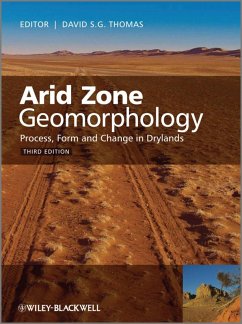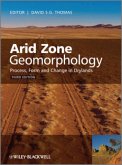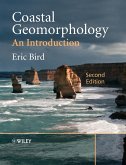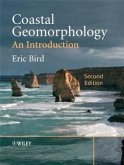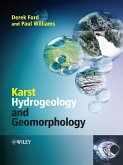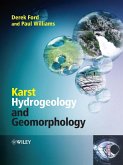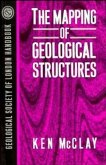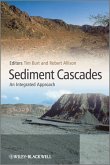Arid Zone Geomorphology
Process, Form and Change in Drylands
Herausgegeben von Thomas, David S. G.
Arid Zone Geomorphology
Process, Form and Change in Drylands
Herausgegeben von Thomas, David S. G.
- Broschiertes Buch
- Merkliste
- Auf die Merkliste
- Bewerten Bewerten
- Teilen
- Produkt teilen
- Produkterinnerung
- Produkterinnerung
The new edition of Arid Zone Geomorphology aims to encapsulate the advances that have been made in recent years in the investigation and explanation of landforms and geomorphological processes in drylands. Building on the success of the previous two editions, the Third Edition has been completely revised and updated to reflect the latest developments in the field. Whilst this latest edition will remain a comprehensive reference to the subject, the book has been restructured to include regional case studies throughout to enhance student understanding and is clearly defined into five distinct…mehr
Andere Kunden interessierten sich auch für
![Arid Zone Geomorphology Arid Zone Geomorphology]() Arid Zone Geomorphology200,99 €
Arid Zone Geomorphology200,99 €![Coastal Geomorphology 2e Coastal Geomorphology 2e]() Eric BirdCoastal Geomorphology 2e99,99 €
Eric BirdCoastal Geomorphology 2e99,99 €![Coastal Geomorphology Coastal Geomorphology]() Eric BirdCoastal Geomorphology205,99 €
Eric BirdCoastal Geomorphology205,99 €![Karst Hydrogeology and Geomorphology Karst Hydrogeology and Geomorphology]() Derek C. FordKarst Hydrogeology and Geomorphology70,99 €
Derek C. FordKarst Hydrogeology and Geomorphology70,99 €![Karst Hydrogeology and Geomorphology Karst Hydrogeology and Geomorphology]() Derek C. FordKarst Hydrogeology and Geomorphology238,99 €
Derek C. FordKarst Hydrogeology and Geomorphology238,99 €![The Mapping of Geological Structures The Mapping of Geological Structures]() K. R. McClayThe Mapping of Geological Structures158,99 €
K. R. McClayThe Mapping of Geological Structures158,99 €![Sediment Cascades Sediment Cascades]() Sediment Cascades201,99 €
Sediment Cascades201,99 €-
-
-
The new edition of Arid Zone Geomorphology aims to encapsulate the advances that have been made in recent years in the investigation and explanation of landforms and geomorphological processes in drylands. Building on the success of the previous two editions, the Third Edition has been completely revised and updated to reflect the latest developments in the field. Whilst this latest edition will remain a comprehensive reference to the subject, the book has been restructured to include regional case studies throughout to enhance student understanding and is clearly defined into five distinct sections; Firstly, the book introduces the reader to Large Scale Controls and Variability in Drylands and then moves on to consider Surface Processes and Characteristics; The Work of Water, The Work of the Wind. The book concludes with a section on Living with Dryland Geomorphology that includes a chapter on geomorphological hazards and the human impact on these environments.
Once again, recognised world experts in the field have been invited to contribute chapters in order to present a comprehensive and up-to-date overview of current knowledge about the processes shaping the landscape of deserts and arid regions. In order to broaden the appeal of the Third Edition, the book has been reduced in extent by 100 pages and the Regional chapters have been omitted in favour of the inclusion of key regional case studies throughout the book. The Editor is also considering the inclusion of a supplementary website that could include further images, problems and case studies.
Hinweis: Dieser Artikel kann nur an eine deutsche Lieferadresse ausgeliefert werden.
Once again, recognised world experts in the field have been invited to contribute chapters in order to present a comprehensive and up-to-date overview of current knowledge about the processes shaping the landscape of deserts and arid regions. In order to broaden the appeal of the Third Edition, the book has been reduced in extent by 100 pages and the Regional chapters have been omitted in favour of the inclusion of key regional case studies throughout the book. The Editor is also considering the inclusion of a supplementary website that could include further images, problems and case studies.
Hinweis: Dieser Artikel kann nur an eine deutsche Lieferadresse ausgeliefert werden.
Produktdetails
- Produktdetails
- Verlag: Wiley & Sons
- 3. Aufl.
- Seitenzahl: 656
- Erscheinungstermin: 14. März 2011
- Englisch
- Abmessung: 262mm x 200mm x 34mm
- Gewicht: 1390g
- ISBN-13: 9780470519097
- ISBN-10: 0470519096
- Artikelnr.: 32567766
- Herstellerkennzeichnung
- Libri GmbH
- Europaallee 1
- 36244 Bad Hersfeld
- gpsr@libri.de
- Verlag: Wiley & Sons
- 3. Aufl.
- Seitenzahl: 656
- Erscheinungstermin: 14. März 2011
- Englisch
- Abmessung: 262mm x 200mm x 34mm
- Gewicht: 1390g
- ISBN-13: 9780470519097
- ISBN-10: 0470519096
- Artikelnr.: 32567766
- Herstellerkennzeichnung
- Libri GmbH
- Europaallee 1
- 36244 Bad Hersfeld
- gpsr@libri.de
David S. G. Thomas is a scientist and geographer. He was born in Buckland Hospital, Dover, Kent, UK, in 1958. He is professor of geography at the University of Oxford, and a professorial fellow of Hertford College, Oxford.
List of contributors.
Preface to the first edition.
Preface to the second edition.
Preface to the third edition.
I Large-scale controls and variability in drylands.
1 Arid environments: their nature and extent (David S.G. Thomas).
1.1 Geomorphology in arid environments.
1.2 Arid zone distinctiveness and the quest for explanation.
1.3 Arid zones: terminology and definitions.
1.4 The age of aridity on Earth.
1.5 The distribution of arid zones.
1.6 Causes of aridity.
1.7 Climate variability.
1.8 Dryland ecosystems.
1.9 Arid zone geomorphology and people.
1.10 Organisation of this book.
2 Tectonic frameworks (Helen Rendell).
2.1 Introduction.
2.2 Tectonic setting of drylands.
2.3 Uplift and erosion, subsidence and sedimentation.
2.4 Lengths of record.
2.5 Existing erosional and depositional records in arid environments.
2.6 Selected examples of the geomorphological impact of active tectonics in
arid environments.
2.7 Conclusions.
3 Climatic frameworks: legacies from the past (David S.G. Thomas and Sallie
L. Burrough).
3.1 Introduction.
3.2 The significance of arid zone fluctuations in the past.
3.3 Dating arid zone fluctuations.
3.4 Climatic interpretations and issues.
3.5 Conclusions.
4 Dryland system variability (David S. G. Thomas).
4.1 A framework for dryland diversity.
4.2 Geomonotony: how unvarying are the 'flat' drylands of the world?
4.3 Within-dryland diversity.
4.4 Summary issues.
5 Extraterrestrial arid surface processes (Jonathan Clarke).
5.1 Introduction.
5.2 What does 'aridity' mean beyond Earth?
5.3 Why should planetary scientists understand terrestrial arid
geomorphology?
5.4 What can terrestrial geomorphologists learn from a solar system
perspective?
5.5 Mars: water-based aridity.
5.6 Titan: methane-based aridity?
5.7 Venus: extreme aridity.
5.8 Future Directions.
II Surface processes and characteristics.
6 Weathering systems (Heather A. Viles).
6.1 Introduction.
6.2 What makes arid environments unusual in terms of weathering systems?
6.3 Theoretical underpinnings of weathering systems research.
6.4 Current weathering study methods.
6.5 Linking processes to form in arid weathering systems.
6.6 Explaining the development of weathering landforms in arid
environments.
6.7 Weathering rates in arid environments.
6.8 Arid weathering and landscape evolution.
6.9 Scale and arid weathering systems.
7 Desert soils (David L. Dunkerley).
7.1 Introduction: the nature and significance of desert soils.
7.2 Taxonomy of desert soils.
7.3 Some distinctive aspects of desert soil development.
7.4 Stone-mantled surfaces and desert pavements.
7.5 Inorganic seals at the soil surface.
7.6 Vesicular soil structures.
7.7 Conclusions.
8 Desert crusts and rock coatings (David J. Nash).
8.1 Introduction.
8.2 Sodium nitrate deposits.
8.3 Halite crusts.
8.4 Gypsum crusts.
8.5 Calcrete.
8.6 Silcrete.
8.7 Desert rock coatings.
8.8 Palaeoenvironmental significance of crusts.
9 Pavements and stone mantles (Julie E. Laity).
9.1 Introduction.
9.2 Surface types: hamadas and stony surfaces.
9.3 General theories concerning stony surface formation.
9.4 Stone pavement characteristics.
9.5 Processes of pavement formation.
9.6 Processes of clast size reduction in pavements.
9.7 Secondary characteristics of pavement surfaces and regional differences
in pavement formation.
9.8 Secondary modifications to pavement surfaces.
9.9 Ecohydrology of pavement surfaces.
9.10 Relative and absolute dating of geomorphic surfaces based on pavement
development.
9.11 Conclusions.
10 Slope systems (John Wainwright and Richard E. Brazier).
10.1 Introduction.
10.2 Badlands.
10.3 Rock slopes.
10.4 Conclusion.
III The work of water.
11 Runoff generation, overland flow and erosion on hillslopes (John
Wainwright and Louise J. Bracken).
11.1 Introduction.
11.2 Infiltration processes.
11.3 Factors affecting infiltration.
11.4 Runoff generation.
11.5 Erosion processes on hillslopes.
11.6 Conclusions.
12 Distinctiveness and diversity of arid zone river systems (Stephen Tooth
and Gerald C. Nanson).
12.1 Introduction.
12.2 Distinctiveness of dryland rivers.
12.3 Diversity of dryland rivers.
12.4 Reassessing distinctiveness and diversity.
12.5 Conclusions.
13 Channel form, flows and sediments of endogenous ephemeral rivers in
deserts (Ian Reid and Lynne E. Frostick).
13.1 Introduction.
13.2 Rainfall and river discharge.
13.3 Ephemeral river channel geometry.
13.4 Fluvial sediment transport.
13.5 Desert river deposits.
13.6 Conclusions.
14 Dryland alluvial fans (Adrian Harvey).
14.1 Introduction: dryland alluvial fans - an overview.
14.2 Process and form on dryland alluvial fans.
14.3 Factors controlling alluvial fan dynamics.
14.4 Alluvial fan dynamics.
14.5 Discussion: significance of dry-region alluvial fans.
15 Pans, playas and salt lakes (Paul A. Shaw and Rob G. Bryant).
15.1 The nature and occurrence of pans, playas and salt lakes.
15.2 Pan hydrology and hydrochemistry.
15.3 Influences of pan hydrology and hydrochemistry on surface morphology.
15.4 Aeolian processes in pan environments.
15.5 Pans and playas as palaeoenvironmental indicators.
16 Groundwater controls and processes (David J. Nash).
16.1 Introduction.
16.2 Groundwater processes in valley and scarp development.
16.3 Groundwater and pan/playa development.
16.4 Groundwater and aeolian processes.
IV The work of the wind.
17 Aeolian landscapes and bedforms (David S.G. Thomas).
17.1 Introduction.
17.2 Aeolian bedforms: scales and relationships.
17.3 The global distribution of sand seas.
17.4 The global distribution of loess.
17.5 Dynamic aeolian landscapes in the Quaternary period.
17.6 Conclusions.
18 Sediment mobilisation by the wind (Giles F. S. Wiggs).
18.1 Introduction.
18.2 The nature of windflow in deserts.
18.3 Sediment in air.
18.4 Determining the threshold of grain entrainment.
18.5 Surface modifications to entrainment thresholds and transport flux.
18.6 Modes of sediment transport.
18.7 Ripples.
18.8 Prediction and measurement of sediment flux.
18.9 The role of turbulence in aeolian sediment transport.
18.10 Conclusions.
19 Desert dune processes and dynamics (Nick Lancaster).
19.1 Introduction.
19.2 Desert dune morphology.
19.3 Dune types and environments.
19.4 Airflow over dunes.
19.5 Dune dynamics.
19.6 Dune development.
19.7 Controls of dune morphology.
19.8 Dune patterns.
19.9 Conclusions.
20 Desert dust (Richard Washington and Giles S. F. Wiggs).
20.1 Introduction.
20.2 Key source areas.
20.3 Temporal changes in dust.
20.4 Future climate change.
20.5 Conclusions.
21 Wind erosion in drylands (Julie E. Laity).
21.1 Introduction.
21.2 The physical setting: conditions for wind erosion.
21.3 Conclusions.
V Living with dryland geomorphology.
22 The human impact (Nick Middleton).
22.1 Introduction.
22.2 Human impacts on soils.
22.3 Human impacts on sand dunes.
22.4 Human impacts on rivers.
22.5 Cause and effect: the arroyo debate continues.
22.6 Conclusions.
23 Geomorphological hazards in drylands (Giles F. S. Wiggs).
23.1 Introduction.
23.2 Aeolian hazards.
23.3 The aeolian dust hazard.
23.4 Agricultural wind erosion.
23.5 Drainage of inland water bodies.
23.6 Fluvial hazards.
23.7 Conclusions.
24 Future climate change and arid zone geomorphology (Richard Washington
and David S. G. Thomas).
24.1 Introduction.
24.2 Climate change projections: basis and uncertainties.
24.3 Overview of global climate change projections in the context of arid
zones.
24.3.1 Methods of establishing climate change impacts in arid zones.
24.4 Climate change and dunes.
24.5 Climate change and dust.
24.6 Climate change and fluvial systems.
24.7 Conclusions.
Index.
Preface to the first edition.
Preface to the second edition.
Preface to the third edition.
I Large-scale controls and variability in drylands.
1 Arid environments: their nature and extent (David S.G. Thomas).
1.1 Geomorphology in arid environments.
1.2 Arid zone distinctiveness and the quest for explanation.
1.3 Arid zones: terminology and definitions.
1.4 The age of aridity on Earth.
1.5 The distribution of arid zones.
1.6 Causes of aridity.
1.7 Climate variability.
1.8 Dryland ecosystems.
1.9 Arid zone geomorphology and people.
1.10 Organisation of this book.
2 Tectonic frameworks (Helen Rendell).
2.1 Introduction.
2.2 Tectonic setting of drylands.
2.3 Uplift and erosion, subsidence and sedimentation.
2.4 Lengths of record.
2.5 Existing erosional and depositional records in arid environments.
2.6 Selected examples of the geomorphological impact of active tectonics in
arid environments.
2.7 Conclusions.
3 Climatic frameworks: legacies from the past (David S.G. Thomas and Sallie
L. Burrough).
3.1 Introduction.
3.2 The significance of arid zone fluctuations in the past.
3.3 Dating arid zone fluctuations.
3.4 Climatic interpretations and issues.
3.5 Conclusions.
4 Dryland system variability (David S. G. Thomas).
4.1 A framework for dryland diversity.
4.2 Geomonotony: how unvarying are the 'flat' drylands of the world?
4.3 Within-dryland diversity.
4.4 Summary issues.
5 Extraterrestrial arid surface processes (Jonathan Clarke).
5.1 Introduction.
5.2 What does 'aridity' mean beyond Earth?
5.3 Why should planetary scientists understand terrestrial arid
geomorphology?
5.4 What can terrestrial geomorphologists learn from a solar system
perspective?
5.5 Mars: water-based aridity.
5.6 Titan: methane-based aridity?
5.7 Venus: extreme aridity.
5.8 Future Directions.
II Surface processes and characteristics.
6 Weathering systems (Heather A. Viles).
6.1 Introduction.
6.2 What makes arid environments unusual in terms of weathering systems?
6.3 Theoretical underpinnings of weathering systems research.
6.4 Current weathering study methods.
6.5 Linking processes to form in arid weathering systems.
6.6 Explaining the development of weathering landforms in arid
environments.
6.7 Weathering rates in arid environments.
6.8 Arid weathering and landscape evolution.
6.9 Scale and arid weathering systems.
7 Desert soils (David L. Dunkerley).
7.1 Introduction: the nature and significance of desert soils.
7.2 Taxonomy of desert soils.
7.3 Some distinctive aspects of desert soil development.
7.4 Stone-mantled surfaces and desert pavements.
7.5 Inorganic seals at the soil surface.
7.6 Vesicular soil structures.
7.7 Conclusions.
8 Desert crusts and rock coatings (David J. Nash).
8.1 Introduction.
8.2 Sodium nitrate deposits.
8.3 Halite crusts.
8.4 Gypsum crusts.
8.5 Calcrete.
8.6 Silcrete.
8.7 Desert rock coatings.
8.8 Palaeoenvironmental significance of crusts.
9 Pavements and stone mantles (Julie E. Laity).
9.1 Introduction.
9.2 Surface types: hamadas and stony surfaces.
9.3 General theories concerning stony surface formation.
9.4 Stone pavement characteristics.
9.5 Processes of pavement formation.
9.6 Processes of clast size reduction in pavements.
9.7 Secondary characteristics of pavement surfaces and regional differences
in pavement formation.
9.8 Secondary modifications to pavement surfaces.
9.9 Ecohydrology of pavement surfaces.
9.10 Relative and absolute dating of geomorphic surfaces based on pavement
development.
9.11 Conclusions.
10 Slope systems (John Wainwright and Richard E. Brazier).
10.1 Introduction.
10.2 Badlands.
10.3 Rock slopes.
10.4 Conclusion.
III The work of water.
11 Runoff generation, overland flow and erosion on hillslopes (John
Wainwright and Louise J. Bracken).
11.1 Introduction.
11.2 Infiltration processes.
11.3 Factors affecting infiltration.
11.4 Runoff generation.
11.5 Erosion processes on hillslopes.
11.6 Conclusions.
12 Distinctiveness and diversity of arid zone river systems (Stephen Tooth
and Gerald C. Nanson).
12.1 Introduction.
12.2 Distinctiveness of dryland rivers.
12.3 Diversity of dryland rivers.
12.4 Reassessing distinctiveness and diversity.
12.5 Conclusions.
13 Channel form, flows and sediments of endogenous ephemeral rivers in
deserts (Ian Reid and Lynne E. Frostick).
13.1 Introduction.
13.2 Rainfall and river discharge.
13.3 Ephemeral river channel geometry.
13.4 Fluvial sediment transport.
13.5 Desert river deposits.
13.6 Conclusions.
14 Dryland alluvial fans (Adrian Harvey).
14.1 Introduction: dryland alluvial fans - an overview.
14.2 Process and form on dryland alluvial fans.
14.3 Factors controlling alluvial fan dynamics.
14.4 Alluvial fan dynamics.
14.5 Discussion: significance of dry-region alluvial fans.
15 Pans, playas and salt lakes (Paul A. Shaw and Rob G. Bryant).
15.1 The nature and occurrence of pans, playas and salt lakes.
15.2 Pan hydrology and hydrochemistry.
15.3 Influences of pan hydrology and hydrochemistry on surface morphology.
15.4 Aeolian processes in pan environments.
15.5 Pans and playas as palaeoenvironmental indicators.
16 Groundwater controls and processes (David J. Nash).
16.1 Introduction.
16.2 Groundwater processes in valley and scarp development.
16.3 Groundwater and pan/playa development.
16.4 Groundwater and aeolian processes.
IV The work of the wind.
17 Aeolian landscapes and bedforms (David S.G. Thomas).
17.1 Introduction.
17.2 Aeolian bedforms: scales and relationships.
17.3 The global distribution of sand seas.
17.4 The global distribution of loess.
17.5 Dynamic aeolian landscapes in the Quaternary period.
17.6 Conclusions.
18 Sediment mobilisation by the wind (Giles F. S. Wiggs).
18.1 Introduction.
18.2 The nature of windflow in deserts.
18.3 Sediment in air.
18.4 Determining the threshold of grain entrainment.
18.5 Surface modifications to entrainment thresholds and transport flux.
18.6 Modes of sediment transport.
18.7 Ripples.
18.8 Prediction and measurement of sediment flux.
18.9 The role of turbulence in aeolian sediment transport.
18.10 Conclusions.
19 Desert dune processes and dynamics (Nick Lancaster).
19.1 Introduction.
19.2 Desert dune morphology.
19.3 Dune types and environments.
19.4 Airflow over dunes.
19.5 Dune dynamics.
19.6 Dune development.
19.7 Controls of dune morphology.
19.8 Dune patterns.
19.9 Conclusions.
20 Desert dust (Richard Washington and Giles S. F. Wiggs).
20.1 Introduction.
20.2 Key source areas.
20.3 Temporal changes in dust.
20.4 Future climate change.
20.5 Conclusions.
21 Wind erosion in drylands (Julie E. Laity).
21.1 Introduction.
21.2 The physical setting: conditions for wind erosion.
21.3 Conclusions.
V Living with dryland geomorphology.
22 The human impact (Nick Middleton).
22.1 Introduction.
22.2 Human impacts on soils.
22.3 Human impacts on sand dunes.
22.4 Human impacts on rivers.
22.5 Cause and effect: the arroyo debate continues.
22.6 Conclusions.
23 Geomorphological hazards in drylands (Giles F. S. Wiggs).
23.1 Introduction.
23.2 Aeolian hazards.
23.3 The aeolian dust hazard.
23.4 Agricultural wind erosion.
23.5 Drainage of inland water bodies.
23.6 Fluvial hazards.
23.7 Conclusions.
24 Future climate change and arid zone geomorphology (Richard Washington
and David S. G. Thomas).
24.1 Introduction.
24.2 Climate change projections: basis and uncertainties.
24.3 Overview of global climate change projections in the context of arid
zones.
24.3.1 Methods of establishing climate change impacts in arid zones.
24.4 Climate change and dunes.
24.5 Climate change and dust.
24.6 Climate change and fluvial systems.
24.7 Conclusions.
Index.
List of contributors.
Preface to the first edition.
Preface to the second edition.
Preface to the third edition.
I Large-scale controls and variability in drylands.
1 Arid environments: their nature and extent (David S.G. Thomas).
1.1 Geomorphology in arid environments.
1.2 Arid zone distinctiveness and the quest for explanation.
1.3 Arid zones: terminology and definitions.
1.4 The age of aridity on Earth.
1.5 The distribution of arid zones.
1.6 Causes of aridity.
1.7 Climate variability.
1.8 Dryland ecosystems.
1.9 Arid zone geomorphology and people.
1.10 Organisation of this book.
2 Tectonic frameworks (Helen Rendell).
2.1 Introduction.
2.2 Tectonic setting of drylands.
2.3 Uplift and erosion, subsidence and sedimentation.
2.4 Lengths of record.
2.5 Existing erosional and depositional records in arid environments.
2.6 Selected examples of the geomorphological impact of active tectonics in
arid environments.
2.7 Conclusions.
3 Climatic frameworks: legacies from the past (David S.G. Thomas and Sallie
L. Burrough).
3.1 Introduction.
3.2 The significance of arid zone fluctuations in the past.
3.3 Dating arid zone fluctuations.
3.4 Climatic interpretations and issues.
3.5 Conclusions.
4 Dryland system variability (David S. G. Thomas).
4.1 A framework for dryland diversity.
4.2 Geomonotony: how unvarying are the 'flat' drylands of the world?
4.3 Within-dryland diversity.
4.4 Summary issues.
5 Extraterrestrial arid surface processes (Jonathan Clarke).
5.1 Introduction.
5.2 What does 'aridity' mean beyond Earth?
5.3 Why should planetary scientists understand terrestrial arid
geomorphology?
5.4 What can terrestrial geomorphologists learn from a solar system
perspective?
5.5 Mars: water-based aridity.
5.6 Titan: methane-based aridity?
5.7 Venus: extreme aridity.
5.8 Future Directions.
II Surface processes and characteristics.
6 Weathering systems (Heather A. Viles).
6.1 Introduction.
6.2 What makes arid environments unusual in terms of weathering systems?
6.3 Theoretical underpinnings of weathering systems research.
6.4 Current weathering study methods.
6.5 Linking processes to form in arid weathering systems.
6.6 Explaining the development of weathering landforms in arid
environments.
6.7 Weathering rates in arid environments.
6.8 Arid weathering and landscape evolution.
6.9 Scale and arid weathering systems.
7 Desert soils (David L. Dunkerley).
7.1 Introduction: the nature and significance of desert soils.
7.2 Taxonomy of desert soils.
7.3 Some distinctive aspects of desert soil development.
7.4 Stone-mantled surfaces and desert pavements.
7.5 Inorganic seals at the soil surface.
7.6 Vesicular soil structures.
7.7 Conclusions.
8 Desert crusts and rock coatings (David J. Nash).
8.1 Introduction.
8.2 Sodium nitrate deposits.
8.3 Halite crusts.
8.4 Gypsum crusts.
8.5 Calcrete.
8.6 Silcrete.
8.7 Desert rock coatings.
8.8 Palaeoenvironmental significance of crusts.
9 Pavements and stone mantles (Julie E. Laity).
9.1 Introduction.
9.2 Surface types: hamadas and stony surfaces.
9.3 General theories concerning stony surface formation.
9.4 Stone pavement characteristics.
9.5 Processes of pavement formation.
9.6 Processes of clast size reduction in pavements.
9.7 Secondary characteristics of pavement surfaces and regional differences
in pavement formation.
9.8 Secondary modifications to pavement surfaces.
9.9 Ecohydrology of pavement surfaces.
9.10 Relative and absolute dating of geomorphic surfaces based on pavement
development.
9.11 Conclusions.
10 Slope systems (John Wainwright and Richard E. Brazier).
10.1 Introduction.
10.2 Badlands.
10.3 Rock slopes.
10.4 Conclusion.
III The work of water.
11 Runoff generation, overland flow and erosion on hillslopes (John
Wainwright and Louise J. Bracken).
11.1 Introduction.
11.2 Infiltration processes.
11.3 Factors affecting infiltration.
11.4 Runoff generation.
11.5 Erosion processes on hillslopes.
11.6 Conclusions.
12 Distinctiveness and diversity of arid zone river systems (Stephen Tooth
and Gerald C. Nanson).
12.1 Introduction.
12.2 Distinctiveness of dryland rivers.
12.3 Diversity of dryland rivers.
12.4 Reassessing distinctiveness and diversity.
12.5 Conclusions.
13 Channel form, flows and sediments of endogenous ephemeral rivers in
deserts (Ian Reid and Lynne E. Frostick).
13.1 Introduction.
13.2 Rainfall and river discharge.
13.3 Ephemeral river channel geometry.
13.4 Fluvial sediment transport.
13.5 Desert river deposits.
13.6 Conclusions.
14 Dryland alluvial fans (Adrian Harvey).
14.1 Introduction: dryland alluvial fans - an overview.
14.2 Process and form on dryland alluvial fans.
14.3 Factors controlling alluvial fan dynamics.
14.4 Alluvial fan dynamics.
14.5 Discussion: significance of dry-region alluvial fans.
15 Pans, playas and salt lakes (Paul A. Shaw and Rob G. Bryant).
15.1 The nature and occurrence of pans, playas and salt lakes.
15.2 Pan hydrology and hydrochemistry.
15.3 Influences of pan hydrology and hydrochemistry on surface morphology.
15.4 Aeolian processes in pan environments.
15.5 Pans and playas as palaeoenvironmental indicators.
16 Groundwater controls and processes (David J. Nash).
16.1 Introduction.
16.2 Groundwater processes in valley and scarp development.
16.3 Groundwater and pan/playa development.
16.4 Groundwater and aeolian processes.
IV The work of the wind.
17 Aeolian landscapes and bedforms (David S.G. Thomas).
17.1 Introduction.
17.2 Aeolian bedforms: scales and relationships.
17.3 The global distribution of sand seas.
17.4 The global distribution of loess.
17.5 Dynamic aeolian landscapes in the Quaternary period.
17.6 Conclusions.
18 Sediment mobilisation by the wind (Giles F. S. Wiggs).
18.1 Introduction.
18.2 The nature of windflow in deserts.
18.3 Sediment in air.
18.4 Determining the threshold of grain entrainment.
18.5 Surface modifications to entrainment thresholds and transport flux.
18.6 Modes of sediment transport.
18.7 Ripples.
18.8 Prediction and measurement of sediment flux.
18.9 The role of turbulence in aeolian sediment transport.
18.10 Conclusions.
19 Desert dune processes and dynamics (Nick Lancaster).
19.1 Introduction.
19.2 Desert dune morphology.
19.3 Dune types and environments.
19.4 Airflow over dunes.
19.5 Dune dynamics.
19.6 Dune development.
19.7 Controls of dune morphology.
19.8 Dune patterns.
19.9 Conclusions.
20 Desert dust (Richard Washington and Giles S. F. Wiggs).
20.1 Introduction.
20.2 Key source areas.
20.3 Temporal changes in dust.
20.4 Future climate change.
20.5 Conclusions.
21 Wind erosion in drylands (Julie E. Laity).
21.1 Introduction.
21.2 The physical setting: conditions for wind erosion.
21.3 Conclusions.
V Living with dryland geomorphology.
22 The human impact (Nick Middleton).
22.1 Introduction.
22.2 Human impacts on soils.
22.3 Human impacts on sand dunes.
22.4 Human impacts on rivers.
22.5 Cause and effect: the arroyo debate continues.
22.6 Conclusions.
23 Geomorphological hazards in drylands (Giles F. S. Wiggs).
23.1 Introduction.
23.2 Aeolian hazards.
23.3 The aeolian dust hazard.
23.4 Agricultural wind erosion.
23.5 Drainage of inland water bodies.
23.6 Fluvial hazards.
23.7 Conclusions.
24 Future climate change and arid zone geomorphology (Richard Washington
and David S. G. Thomas).
24.1 Introduction.
24.2 Climate change projections: basis and uncertainties.
24.3 Overview of global climate change projections in the context of arid
zones.
24.3.1 Methods of establishing climate change impacts in arid zones.
24.4 Climate change and dunes.
24.5 Climate change and dust.
24.6 Climate change and fluvial systems.
24.7 Conclusions.
Index.
Preface to the first edition.
Preface to the second edition.
Preface to the third edition.
I Large-scale controls and variability in drylands.
1 Arid environments: their nature and extent (David S.G. Thomas).
1.1 Geomorphology in arid environments.
1.2 Arid zone distinctiveness and the quest for explanation.
1.3 Arid zones: terminology and definitions.
1.4 The age of aridity on Earth.
1.5 The distribution of arid zones.
1.6 Causes of aridity.
1.7 Climate variability.
1.8 Dryland ecosystems.
1.9 Arid zone geomorphology and people.
1.10 Organisation of this book.
2 Tectonic frameworks (Helen Rendell).
2.1 Introduction.
2.2 Tectonic setting of drylands.
2.3 Uplift and erosion, subsidence and sedimentation.
2.4 Lengths of record.
2.5 Existing erosional and depositional records in arid environments.
2.6 Selected examples of the geomorphological impact of active tectonics in
arid environments.
2.7 Conclusions.
3 Climatic frameworks: legacies from the past (David S.G. Thomas and Sallie
L. Burrough).
3.1 Introduction.
3.2 The significance of arid zone fluctuations in the past.
3.3 Dating arid zone fluctuations.
3.4 Climatic interpretations and issues.
3.5 Conclusions.
4 Dryland system variability (David S. G. Thomas).
4.1 A framework for dryland diversity.
4.2 Geomonotony: how unvarying are the 'flat' drylands of the world?
4.3 Within-dryland diversity.
4.4 Summary issues.
5 Extraterrestrial arid surface processes (Jonathan Clarke).
5.1 Introduction.
5.2 What does 'aridity' mean beyond Earth?
5.3 Why should planetary scientists understand terrestrial arid
geomorphology?
5.4 What can terrestrial geomorphologists learn from a solar system
perspective?
5.5 Mars: water-based aridity.
5.6 Titan: methane-based aridity?
5.7 Venus: extreme aridity.
5.8 Future Directions.
II Surface processes and characteristics.
6 Weathering systems (Heather A. Viles).
6.1 Introduction.
6.2 What makes arid environments unusual in terms of weathering systems?
6.3 Theoretical underpinnings of weathering systems research.
6.4 Current weathering study methods.
6.5 Linking processes to form in arid weathering systems.
6.6 Explaining the development of weathering landforms in arid
environments.
6.7 Weathering rates in arid environments.
6.8 Arid weathering and landscape evolution.
6.9 Scale and arid weathering systems.
7 Desert soils (David L. Dunkerley).
7.1 Introduction: the nature and significance of desert soils.
7.2 Taxonomy of desert soils.
7.3 Some distinctive aspects of desert soil development.
7.4 Stone-mantled surfaces and desert pavements.
7.5 Inorganic seals at the soil surface.
7.6 Vesicular soil structures.
7.7 Conclusions.
8 Desert crusts and rock coatings (David J. Nash).
8.1 Introduction.
8.2 Sodium nitrate deposits.
8.3 Halite crusts.
8.4 Gypsum crusts.
8.5 Calcrete.
8.6 Silcrete.
8.7 Desert rock coatings.
8.8 Palaeoenvironmental significance of crusts.
9 Pavements and stone mantles (Julie E. Laity).
9.1 Introduction.
9.2 Surface types: hamadas and stony surfaces.
9.3 General theories concerning stony surface formation.
9.4 Stone pavement characteristics.
9.5 Processes of pavement formation.
9.6 Processes of clast size reduction in pavements.
9.7 Secondary characteristics of pavement surfaces and regional differences
in pavement formation.
9.8 Secondary modifications to pavement surfaces.
9.9 Ecohydrology of pavement surfaces.
9.10 Relative and absolute dating of geomorphic surfaces based on pavement
development.
9.11 Conclusions.
10 Slope systems (John Wainwright and Richard E. Brazier).
10.1 Introduction.
10.2 Badlands.
10.3 Rock slopes.
10.4 Conclusion.
III The work of water.
11 Runoff generation, overland flow and erosion on hillslopes (John
Wainwright and Louise J. Bracken).
11.1 Introduction.
11.2 Infiltration processes.
11.3 Factors affecting infiltration.
11.4 Runoff generation.
11.5 Erosion processes on hillslopes.
11.6 Conclusions.
12 Distinctiveness and diversity of arid zone river systems (Stephen Tooth
and Gerald C. Nanson).
12.1 Introduction.
12.2 Distinctiveness of dryland rivers.
12.3 Diversity of dryland rivers.
12.4 Reassessing distinctiveness and diversity.
12.5 Conclusions.
13 Channel form, flows and sediments of endogenous ephemeral rivers in
deserts (Ian Reid and Lynne E. Frostick).
13.1 Introduction.
13.2 Rainfall and river discharge.
13.3 Ephemeral river channel geometry.
13.4 Fluvial sediment transport.
13.5 Desert river deposits.
13.6 Conclusions.
14 Dryland alluvial fans (Adrian Harvey).
14.1 Introduction: dryland alluvial fans - an overview.
14.2 Process and form on dryland alluvial fans.
14.3 Factors controlling alluvial fan dynamics.
14.4 Alluvial fan dynamics.
14.5 Discussion: significance of dry-region alluvial fans.
15 Pans, playas and salt lakes (Paul A. Shaw and Rob G. Bryant).
15.1 The nature and occurrence of pans, playas and salt lakes.
15.2 Pan hydrology and hydrochemistry.
15.3 Influences of pan hydrology and hydrochemistry on surface morphology.
15.4 Aeolian processes in pan environments.
15.5 Pans and playas as palaeoenvironmental indicators.
16 Groundwater controls and processes (David J. Nash).
16.1 Introduction.
16.2 Groundwater processes in valley and scarp development.
16.3 Groundwater and pan/playa development.
16.4 Groundwater and aeolian processes.
IV The work of the wind.
17 Aeolian landscapes and bedforms (David S.G. Thomas).
17.1 Introduction.
17.2 Aeolian bedforms: scales and relationships.
17.3 The global distribution of sand seas.
17.4 The global distribution of loess.
17.5 Dynamic aeolian landscapes in the Quaternary period.
17.6 Conclusions.
18 Sediment mobilisation by the wind (Giles F. S. Wiggs).
18.1 Introduction.
18.2 The nature of windflow in deserts.
18.3 Sediment in air.
18.4 Determining the threshold of grain entrainment.
18.5 Surface modifications to entrainment thresholds and transport flux.
18.6 Modes of sediment transport.
18.7 Ripples.
18.8 Prediction and measurement of sediment flux.
18.9 The role of turbulence in aeolian sediment transport.
18.10 Conclusions.
19 Desert dune processes and dynamics (Nick Lancaster).
19.1 Introduction.
19.2 Desert dune morphology.
19.3 Dune types and environments.
19.4 Airflow over dunes.
19.5 Dune dynamics.
19.6 Dune development.
19.7 Controls of dune morphology.
19.8 Dune patterns.
19.9 Conclusions.
20 Desert dust (Richard Washington and Giles S. F. Wiggs).
20.1 Introduction.
20.2 Key source areas.
20.3 Temporal changes in dust.
20.4 Future climate change.
20.5 Conclusions.
21 Wind erosion in drylands (Julie E. Laity).
21.1 Introduction.
21.2 The physical setting: conditions for wind erosion.
21.3 Conclusions.
V Living with dryland geomorphology.
22 The human impact (Nick Middleton).
22.1 Introduction.
22.2 Human impacts on soils.
22.3 Human impacts on sand dunes.
22.4 Human impacts on rivers.
22.5 Cause and effect: the arroyo debate continues.
22.6 Conclusions.
23 Geomorphological hazards in drylands (Giles F. S. Wiggs).
23.1 Introduction.
23.2 Aeolian hazards.
23.3 The aeolian dust hazard.
23.4 Agricultural wind erosion.
23.5 Drainage of inland water bodies.
23.6 Fluvial hazards.
23.7 Conclusions.
24 Future climate change and arid zone geomorphology (Richard Washington
and David S. G. Thomas).
24.1 Introduction.
24.2 Climate change projections: basis and uncertainties.
24.3 Overview of global climate change projections in the context of arid
zones.
24.3.1 Methods of establishing climate change impacts in arid zones.
24.4 Climate change and dunes.
24.5 Climate change and dust.
24.6 Climate change and fluvial systems.
24.7 Conclusions.
Index.

